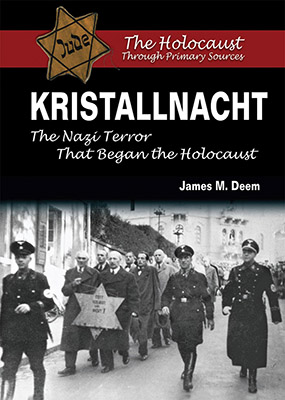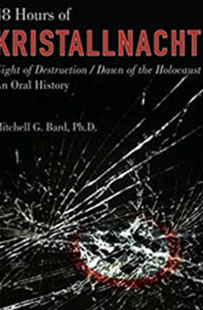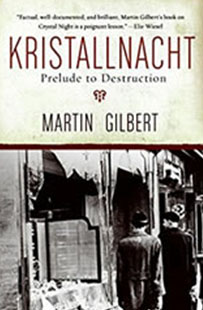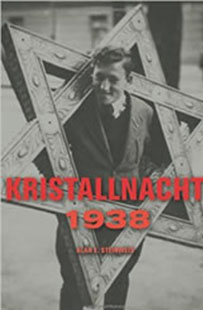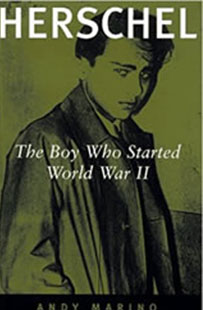Paperback edition, 2012. |
~~ Excerpt ~~ Teacher's Guide ~~ ~~ Related Books by James M Deem: The Prisoners of Breendonk ~~ Auschwitz ~~ |
Kristallnacht: The Nazi Terror That Began the Holocaust discusses the events leading up to Kristallnacht, a four-day pogrom instigated by the Nazis against the Jews of Germany and Austria in November 1938, and how it marked the beginning of the Holocaust.
The book focuses on ten individuals who lived through Kristallnacht:
Chapter 1. Herschel Grynszpan (whose assassination of a German official in Paris provided Nazi officials with the excuse for increased violence against Jews)
In an unsent postcard to his parents (found after the assassination), he wrote: "May God forgive me. My heart bleeds at the news of [the] Jews’ suffering. I must protest in such a way that the world will hear me. I must do it. Forgive me. Herschel."
Chapter 2. Joseph Goebbels (the Nazi's minister for propaganda and public enlightenment who helped direct the pogrom)
On his admiration of Hitler, he wrote: Hitler "greets me like an old friend. He speaks to us all the evening. I can’t hear enough of it. He gives me his picture . . . inscribed “Heil Hitler!”. . . I would love to have Hitler as my friend. His picture stands on my table. I could not bear to have to doubt that man!"
Chapter 3. Hannele Zürndorfer (who experienced Kristallnacht in a suburb of Düsseldorf and was sent on the kindertransport to England)
On her memories of Kristallnacht, when her home was invaded: "Seconds later there burst into this room a horde of violent monsters, their faces contorted into raving masks of hatred, some red, some pale, all screaming and shouting, eyes rolling, teeth bared, wild hands flailing, jackboots kicking...."
Chapter 4. Fred Spiegel (who experienced Kristallnacht in Dinslaken and survived the concentration camp of Bergen-Belsen)
On his discovering the destruction in his family's apartment after Kristallnacht: "Upon entering, I found that many things had been totally destroyed, the windows broken, and much of our furniture and crystal was on the pavement below. My mother, sister, and Aunt Klara were standing on the balcony crying. My grandfather had been arrested and taken away by two policemen...."
Chapter 5. Ernest Fontheim (who experienced Kristallnacht in Berlin and survived a slave-labor factory)
On witnessing the burning of a Berlin synagogue: "The fire department . . . hosing down adjacent buildings so to prevent the flames from doing damage to Germany property and no hose was directed at the synagogue. . . . And then, there were many anti-Semitic shouts from the mob . . . like . . . “throw out the Jews” or “kill the Jews” and it never occurred to me that I was one in the middle of the mob...."
Chapter 6. Marianne Strauss (who experienced Kristallnacht in Essen and lived in hiding throughout the war)
On her own unusual memories of Kristallnacht: Marianne "did not know that Essen’s synagogue had been burned or that shop windows had been smashed until she went to school the next day. A classmate greeted her by yelling, “You old Jew, get lost, you’ve no business here.” Then she hit Marianne on the head with a heavy book. A short time later, Marianne went home and never returned to the school...."
Chapter 7. Jurgen Herbst (who witnessed Kristallnacht as a German Christian and later joined the Hitler Youth movement and the German military before renouncing his past)
On seeing a vandalized store one morning, unaware of Kristallnacht: "It was the only store window in which I had noticed before a red and white sign stuck in the corner which said: “Germans: Buy German—Don’t Patronize a Jewish Business.” Now, the jagged slivers of glass aroused my curiosity. . . . I walked across the street and then stared at the ladies’, purses, shoes, and gloves that lay . . . covered with pulverized glass. And there, resting among the still well-polished pumps and slippers, lay half a brick. . . . I figured an accident had happened in the night."
Chapter 8. Arnold Blum (who experienced Kristallnacht in Stuttgart and then emigrated to America to become a soldier and fight the Nazis)
On his memories of Dachau concentration camp, after Jewish men were rounded up and imprisoned there: "We would be marched to the drill field every morning and evening to be counted. There would be no food until the count was accepted by the SS. In the unlikely event of an escape, no prisoner could eat until the escapee was caught and returned. Anyone dying during the day or night had to be carried to the drill field for the count. . . . Our names were not to be used. Instead we were to refer to ourselves as Schutzhaftjude, Jew in Protective Custody, and our camp number...."
Chapter 9. Alfred Werner (who experienced Kristallnacht in Vienna, Austria, and was incarcerated at Dachau before emigrating to the United States)
On his memories of being jailed in Vienna as a result of Kristallnacht: "On our arrival we had to run the gauntlet of a wild mob who beat us with sticks and iron bars. The first [man] to enter the barracks was shot at once. On entering the hall, he had stumbled against a Nazi guard, and another Nazi, interpreting it as a hostile act, had pressed the trigger...."
Chapter 10. Albert Fuchs (a lawyer who experienced Kristallnacht in Karlsruhe and escaped to the safety of France before emigrating with his family to Canada)
On his memories of receiving two phone calls during Kristallnacht: "The first phone call rang at three o’clock in the morning of November 10. An unknown male caller warned the family that they should be 'most careful.' Albert and his wife were not sure what to do, since they felt safe in their home. They could not go back to sleep, but they listened alertly to any sounds outside. A second call at four-thirty that morning came from another unknown male speaking from a pay phone. The voice told his wife, 'Why don’t you quickly lead your husband to safety?' "
Honors and Reviews
2012 Society of School Librarians International Honor Book Award in Social Studies
Booklist
"Personal testimony is a powerful way to tell history, especially if there is no rambling repetition, and these accounts ... are tightly edited, drawing on the memories of victims, perpetrators, and witnesses who were at the Night of Broken Glass in 1938. The viewpoints are from children, adults, Jews, and Nazis who saw homes, businesses, and synagogues destroyed, and people beaten, murdered, and deported to concentration camps. Each chapter blends an individual’s testimony with historical background and commentary as well as photos of the witness and of the brutal events. One chapter is on Joseph Goebbels, Hitler’s minister of propaganda, with quotes from his diary about how he directed the pogrom. But most accounts are about ordinary people: a teen in Hitler Youth; an assimilated Jewish boy in Berlin, who watched his world burn down and survived the transports and the camps; a girl thrown out of school, who saw her home destroyed and escaped on a Kindertransport to England."
TriState Reviews
"Through first hand accounts, the first terrible night of violence against Jews in Nazi Germany is recounted.
...[W]what makes this book exceptional is that it is written for the tween student in the voice of the subjects about whom the book is about. First hand accounts, memoirs verbal and written add such a strong voice to the subject in this book and make for compelling reading for not just the student but anyone who picks up this book to read. The black and white imagery throughout the text keeps it in the period, and narratives are written in a ‘handwriting’ font which also keeps the context of the book intact. Sidebars throughout the book serve to emphasize specific occurrences such as “Kristallnacht instructions for Gestapo and state police”, page 36 and “A German firefighter remembers”, page 79. The book concludes with a timeline, chapter notes, a glossary, further reading and an index."
